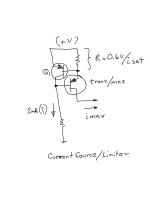Have you considered a fuse?I was looking for a current limiter (say 100 mA)
The collector current of a PNP such as MJE5852 can be limited to a desired value by limiting the base current.
This will serve the purpose of a current limiter.
Patrick
This will serve the purpose of a current limiter.
Patrick
I use just a saturated current source, having used one recently to produce about 120mA for my purpose, as similar to above (just drawn differently). This is easy to adapt to high voltage as Q1 is a low voltage type (used preceding a regulator). The pass device needs to sustain the full voltage however.


This is the worst method of limiting current and at the same time the most inaccurate.The collector current of a PNP such as MJE5852 can be limited to a desired value by limiting the base current.
This will serve the purpose of a current limiter.
Patrick
The gain of a transistor is not clearly defined and varies greatly from sample to sample.
Moreover, it varies very strongly with temperature and when it reaches the limit the current is the highest possible and this also leads to an increase in temperature which leads to an increase in the limited values which leads to an even stronger heating which again leads to an increase in current. It is an avalanche phenomenon and very difficult to control in practice.
I put one of the possible options in post no. 20 but it was completely ignored.
How would you know if it was "completely ignored"?
It seems just protection if you are prepared to use a fuse, hence providing heat-sinking to the pass transistor of #44 above is all that you seem to need. You may be getting into instability problems with the LM317 as causing this device not to function predictably.
Not sure if you are current limiting or current regulating? Is it a resistive load that you will ultimately use? How accurate do you want the set current? Is this for protection or function?Elvee,
I was looking for a current limiter (say 100 mA), regardless of the applied voltage (above a certain value of course). The intended range would be from 150 to 400 Volt.
Perhaps a 10M45S will do, I haven’t tried this yet.
Regards, Gerrit
It seems just protection if you are prepared to use a fuse, hence providing heat-sinking to the pass transistor of #44 above is all that you seem to need. You may be getting into instability problems with the LM317 as causing this device not to function predictably.
Last edited:
Hi Hierfi,
It would be to limit the max. current, be it 10, 50 or 100 mA, regardless of the voltage.
Regards, Gerrit
It would be to limit the max. current, be it 10, 50 or 100 mA, regardless of the voltage.
Regards, Gerrit
Are you planning an interposing a voltage regulator? Is it actually a resistive load or active? How loose do you want the current setting? By that I mean how much do you want current to vary in relation to voltage variance?
It isn’t a current limiter. It is a current regulator, or constant-current source. Not the same thing.It would be to limit the max. current, be it 10, 50 or 100 mA, regardless of the voltage.
This will work, provided the MOS has a decent linear SOA:
You can always reverse the polarity of the semi's, or rearrange the elements like this for example:

To remain on the safe side, the usual additional protection zener is advisable:

- Home
- Amplifiers
- Power Supplies
- LM317 current limiter